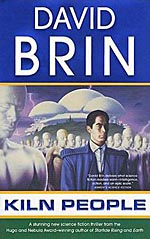
![]() Rhondak101
Rhondak101
12/21/2011
![]()
I read Kiln People while I was teaching the class that I discussed in my Automata 101 blog. The book was originally on my short list of books to investigate for the class, but I ran out of time before I had a chance to read it. The book's premise appealed to me on a couple of levels. The setting is a near-future Earth in which people have the ability to make dittos of themselves that can run their errands, do their taxes, or complete other tasks. The dittos are color coded to indicate their ability to accomplish intricate tasks. For example, greens complete routine, mundane jobs; grays demonstrate higher level skills; ebonies performe higher mental work and analysis; and ivories are programmed for pleasure. At the end of twenty-four hours or so, the dittos return and upload their memories and experiences to the original person, called the archetype, or archie, for short. (As a reader, I started fantasizing about sending a few dittos to school to teach, grade papers, and attend committee meetings, while I stayed home and read novels.)
I appreciated the way that the book incorporated the golem mythos. The dittos were made of a type of clay and were called golems. The process was perfected by the scientist Yosil Marahal, a nod to Rabbi Marahal, the golem maker of Prague. When a golem or ditto became rogue and did not want to complete the tasks assigned or did not want to return to upload its memories, then that golem was called a Frankie, a Frankenstein, based on the golem who disobeys and challenges its master. As you can see Brin was having fun in his world building.
The story is about private detective, Albert Morris, whose primarily business is finding counterfeit dittos of celebrities that are being used in ways that their archies would not sanction. This plot has a lot of promise as Morris' case begins to grow and includes breaking up the counterfeiting ring and discovering corporate espionage and collusion. The story is told from the point of view of Albert and several of his dittos, including a green who becomes a Frankie. It is very interesting approach as the reader can see how each version of Morris works his part of the case. The hard-boiled tone of the novel made me think that I was reading an updated Philip Marlowe, and for the first four-hundred pages, I was sold. I wanted to read more Albert Morris and his cases. I wanted sequels. However, the last 150 pages ruined it for me. Suddenly, the struggle moved into the psyche of Albert and his dittos, meaning that the narrative becomes interior, scattered and impossible to follow. I pushed through to the end, but it was a painful read.
I still love the premise of the book. There's so much nuance to the society that he creates and so much that could be done with it. However, the plot does not live up to the premise.